Cradle-to-Gate Water-Related Impacts on Production of Traditional Food Products in Malaysia
Abstract
:1. Introduction
2. Materials and Methods
2.1. Goal and Scope Definition
Description of Food Products
2.2. Water Footprint Accounting
2.3. Water Footprint Sustainability Assessment
2.4. Water-Related Impact Assessment
2.4.1. Goal and Scope Definition
2.4.2. Life Cycle Inventory (LCI)
2.4.3. Life Cycle Impact Analysis (LCIA)
3. Results and Discussion
3.1. Water Footprint Accounting
3.2. Scarcity Potential
3.3. Life Cycle Analysis Results
3.3.1. Freshwater Eutrophication (FEP)
3.3.2. Marine Eutrophication (MEP)
3.3.3. Freshwater Ecotoxicity (FETP)
3.3.4. Marine Ecotocixity (METP)
3.3.5. Water Consumption (WCP)
4. Conclusions
Recommendations for Future Studies
Author Contributions
Funding
Acknowledgments
Conflicts of Interest
References
- Food and Agriculture Organization of the United Nations (FAO). Water for Sustainable Food and Agriculture Water for Sustainable Food and Agriculture; Food and Agriculture Organization of the United Nations: Rome, Italy, 2017. [Google Scholar]
- Hanafiah, M.M.; Fadillah, N.; Norliyana, S.; Saadoon, H.; Abdulhasan, M.J. Assessing water scarcity in Malaysia: A case study of rice production. Desalin. Water Treat. 2019, 149, 274–287. [Google Scholar] [CrossRef] [Green Version]
- Borsato, E.; Giubilato, E.; Zabeo, A.; Lamastra, L.; Criscione, P.; Tarolli, P.; Marinello, F.; Pizzol, L. Comparison of Water-focused Life Cycle Assessment and Water Footprint Assessment: The case of an Italian wine. Sci. Total Environ. 2019, 666, 1220–1231. [Google Scholar] [CrossRef] [PubMed]
- De Miguel, Á.; Hoekstra, A.Y.; García-Calvo, E. Sustainability of the water footprint of the Spanish pork industry. Ecol. Indic. 2015, 57, 465–474. [Google Scholar] [CrossRef]
- Muhammad-Muaz, A.; Marlia, M.H. Water footprint assessment of oil palm in Malaysia: A preliminary study. AIP Conf. Proc. 2015, 1614, 803–807. [Google Scholar]
- Hoekstra, A.Y.; Hung, P.Q. Virtual Water Trade: A Quantification of Virtual Water Flows Between Nations in Relation to International Crop Trade (Report No. 11); IHE Delft Institute for Water Education: Delft, The Netherlands, 2002. [Google Scholar]
- Wang, F.; Wang, S.; Li, Z.; You, H.; Aviso, K.B.; Tan, R.R.; Jia, X. Water footprint sustainability assessment for the chemical sector at the regional level. Resour. Conserv. Recycl. 2019, 142, 69–77. [Google Scholar] [CrossRef]
- Allan, J.A. Water use and development in arid regions: Environment, economic development and water resource politics and policy. Rev. Eur. Community Int. Environ. Law 1996, 5, 107–115. [Google Scholar] [CrossRef]
- Aziz, N.I.H.A.; Hanafiah, M.M. Life cycle analysis of biogas production from anaerobic digestion of palm oil mill effluent. Renew. Energy 2020, 145, 847–857. [Google Scholar] [CrossRef]
- Aris, T.; Zainuddin, A.A.; Ahmad, N.A.; Yoep, N. National Health And Morbidity Survey 2014: Malaysia Adult Nutrition Survey (NMRR-12-815-13100); Institute for Public Health, National Institutes of Health, Ministry of Health: Kuala Lumpur, Malaysia, 2014. [Google Scholar]
- Fermentation in Food Processing. Available online: https://en.wikipedia.org/w/index.php?title=Fermentation_in_food_processing&oldid=951006228 (accessed on 15 June 2020).
- Jefferies, D.; Muñoz, I.; Hodges, J.; King, V.J.; Aldaya, M.; Ercin, A.E.; Milà i Canals, L.; Hoekstra, A.Y. Water footprint and life cycle assessment as approaches to assess potential impacts of products on water consumption. Key learning points from pilot studies on tea and margarine. J. Clean. Prod. 2012, 33, 155–166. [Google Scholar] [CrossRef] [Green Version]
- Hoekstra, A.Y.; Chapagain, A.K.; Aldaya, M.M. The Water Footprint Assessment Manual: Setting the Global Standard; Earthscan: London, UK; Washington, DC, USA, 2011. [Google Scholar]
- Ridoutt, B.G.; Pfister, S. A revised approach to water footprinting to make transparent the impacts of consumption and production on global freshwater scarcity. Glob. Environ. Chang. 2010, 20, 113–120. [Google Scholar] [CrossRef]
- International Organization for Standardization (ISO). Malaysian Standard MS ISO 14046:2017—Principles, Requirements and Guidelines; International Organization for Standardization: Geneva, Switzerland, 2017. [Google Scholar]
- Yu, Y.; Hubacek, K.; Feng, K.; Guan, D. Assessing regional and global water footprints for the UK. Ecol. Econ. 2010, 69, 1140–1147. [Google Scholar] [CrossRef]
- Bai, X.; Ren, X.; Khanna, N.Z.; Zhou, N.; Hu, M. Comprehensive water footprint assessment of the dairy industry chain based on ISO 14046: A case study in China. Resour. Conserv. Recycl. 2018, 132, 369–375. [Google Scholar] [CrossRef]
- Pfister, S.; Boulay, A.-M.; Berger, M.; Hadjikakou, M.; Motoshita, M.; Hess, T. Understanding the LCA and ISO water footprint: A response to Hoekstra (2016) “A critique on the water-scarcity weighted water footprint in LCA”. Ecol. Indic. 2017, 72, 352–359. [Google Scholar] [CrossRef] [PubMed]
- Gheewala, S.H.; Silalertruksa, T.; Nilsalab, P.; Mungkung, R.; Perret, S.R.; Chaiyawannakarn, N. Water Footprint and Impact of Water Consumption for Food, Feed, Fuel Crops Production in Thailand. Water 2014, 6, 1698–1718. [Google Scholar] [CrossRef] [Green Version]
- Mekonnen, M.M.; Hoekstra, A.Y. Volume 1: Main Report, vol. 1, no. 48; UNESCO-IHE Institute for Water Education: Delft, The Netherlands, 2010. [Google Scholar]
- Mekonnen, M.M.; Hoekstra, A.Y. Volume 1: Main Report, vol. 1, no. 47; UNESCO-IHE Institute for Water Education: Delft, The Netherlands, 2010. [Google Scholar]
- Kandananon, K. Author. The Utilization of Water Footprint to Enhance the Water Saving Awareness: Case Study Of A Ceramic Product. Int. J. GEOMATE. 2018, 14, 107–112. [Google Scholar]
- Zygmunt, J. Hidden Waters; Waterwise: London, UK, 2007. [Google Scholar]
- Franzén, L. Water Flow Analysis of Jästbolaget: An Assessment of the Yeast Production’s Environmental Impact, Caused by Its Water Consumption. Bachelor’s Thesis, KTH Royal Institute of Technology, Stockholm, Sweden, 2014. [Google Scholar]
- Weidema, B.P.; Bauer, C.; Hischier, R.; Mutel, C.; Nemecek, T.; Reinhard, J.; Vadenbo, C.O.; Wernet, G. Overview and Methodology: Data Quality Guideline for the Ecoinvent Database Version 3; Ecoinvent Report 1 (v3); The Ecoinvent Centre: St. Gallen, Switzerland, 2013. [Google Scholar]
- Guinée, J.B.; Lindeijer, E. Handbook on Life Cycle Assessment: Operational Guide to the ISO standards; Springer Science & Business Media: Berlin/Heidelberg, Germany, 2002; Volume 7. [Google Scholar]
- Roy, P.; Nei, D.; Orikasa, T.; Xu, Q.; Okadome, H.; Nakamura, N.; Shiina, T. A review of life cycle assessment (LCA) on some food products. J. Food Eng. 2009, 90, 1–10. [Google Scholar] [CrossRef]
- Nunes, F.A.; Seferin, M.; Maciel, V.G.; Flôres, S.H.; Ayub, M.A.Z. Life cycle greenhouse gas emissions from rice production systems in Brazil: A comparison between minimal tillage and organic farming. J. Clean. Prod. 2016, 139, 799–809. [Google Scholar] [CrossRef]
- Sellahewa, J.; Martindale, W. The impact of food processing on the sustainability of the food supply chain. Asp. Appl. Biol. 2010, 102, 91–98. [Google Scholar]
- Lansche, J.; Awiszus, S.; Latif, S.; Müller, J. Potential of Biogas Production from Processing Residues to Reduce Environmental Impacts from Cassava Starch and Crisp Production—A Case Study from Malaysia. Appl. Sci. 2020, 10, 2975. [Google Scholar] [CrossRef]
- Bhattacharyya, N.; Goodell, A.; Rogers, S.; Demond, A. Environmental impacts of wheat-based vodka production using life cycle assessment. J. Clean. Prod. 2019, 231, 642–648. [Google Scholar] [CrossRef]
- Perez-Martinez, M.M.; Noguerol, R.; Casales, B.I.; Lois, R.; Soto, B. Evaluation of environmental impact of two ready-to-eat canned meat products using Life Cycle Assessment. J. Food Eng. 2018, 237, 118–127. [Google Scholar] [CrossRef]
- Caldeira, C.; Quinteiro, P.; Castanheira, E.; Boulay, A.-M.; Arroja, L.; Freire, F.; Dias, A.C. Water footprint profile of crop-based vegetable oils and waste cooking oil: Comparing two water scarcity footprint methods. J. Clean. Prod. 2018, 195, 1190–1202. [Google Scholar] [CrossRef]
- Jimmy, A.; Khan, N.; Hossain, M.; Sujauddin, M. Evaluation of the environmental impacts of rice paddy production using life cycle assessment: Case study in Bangladesh. Modeling Earth Syst. Environ. 2017, 3, 1691–1705. [Google Scholar] [CrossRef]
- Cha, K.; Son, M.; Hong, S.; An, S.; Part, S. Method to assess water footprint, a case study for white radishes in Korea. Int. Soil Water Conserv. Res. 2017, 5, 151–157. [Google Scholar] [CrossRef]
- Huerta, A.R.; Güereca, L.P.; de la Salud Rubio Lozono, M. Environmental impact of beef production in Mexico through life cycle assessment.pdf. Resour. Conserv. Recycl. 2016, 109, 44–53. [Google Scholar] [CrossRef]
- Nilsson, K.; Sund, V.; Florén, B. The Environmental Impact of the Consumption of Sweets, Crisps and Soft Drinks; Nordic Council of Ministers: Copenhagen, Denmark, 2011. [Google Scholar]
- Bevilacqua, M.; Braglia, M.; Carmignani, G.; Zammori, F.A. Life cycle assessment of pasta production in Italy. J. Food Qual. 2007, 30, 932–952. [Google Scholar] [CrossRef]
- Ingrao, C.; Selvaggi, R.; Valenti, F.; Matarazzo, A.; Pecorino, B.; Arcidiacono, C. Life cycle assessment of expanded clay granulate production using different fuels. Resour. Conserv. Recycl. 2019, 141, 398–409. [Google Scholar] [CrossRef]
- Durlinger, B.; Tyszler, M.; Scholten, J.; Broekema, R.; Blonk, H.; Beatrixstraat, G. Agri-Footprint; a Life Cycle Inventory database covering food and feed production and processing. In Proceedings of the 9th International Conference on Life Cycle Assessment in the Agri-Food Sector, San Francisco, CA, USA, 8–10 October 2014; pp. 310–317. [Google Scholar]
- Huijbregts, M.; Steinmann, Z.J.N.; Elshout, P.M.F.; Stam, G.; Verones, F.; Vieira, M.D.M.; Hollander, A.; Zijp, M.; van Zelm, R. ReCiPe; National Institute for Public Healthand the Environment: Bilthoven, The Netherlands, 2016. [Google Scholar]
- Percetakan Nasional Malaysia Berhad. Environmental Quality Act 1974; Environmental Quality (Industrial Effluent) Regulations 2009; Percetakan Nasional Malaysia Berhad: Kuala Lumpur, Malaysia, 2009. [Google Scholar]
- Mekonnen, M.M.; Hoekstra, A.Y. A Global Assessment of the Water Footprint of Farm Animal Products. Ecosystems 2012, 15, 401–415. [Google Scholar] [CrossRef] [Green Version]
- Hanafiah, M.M.; Xenopoulos, M.A.; Pfister, S.; Leuven, R.S.E.W.; Huijbregts, M.A.J. Characterization Factors for Water Consumption and Greenhouse Gas Emissions Based on Freshwater Fish Species Extinction. Environ. Sci. Technol. 2011, 45, 5272–5278. [Google Scholar] [CrossRef] [Green Version]
- Pfister, S.; Koehler, A.; Hellweg, S. Assessing the Environmental Impacts of Freshwater Consumption in Life Cycle Assessment. Environ. Sci. Technol. 2009, 43, 4098–4104. [Google Scholar] [CrossRef] [Green Version]
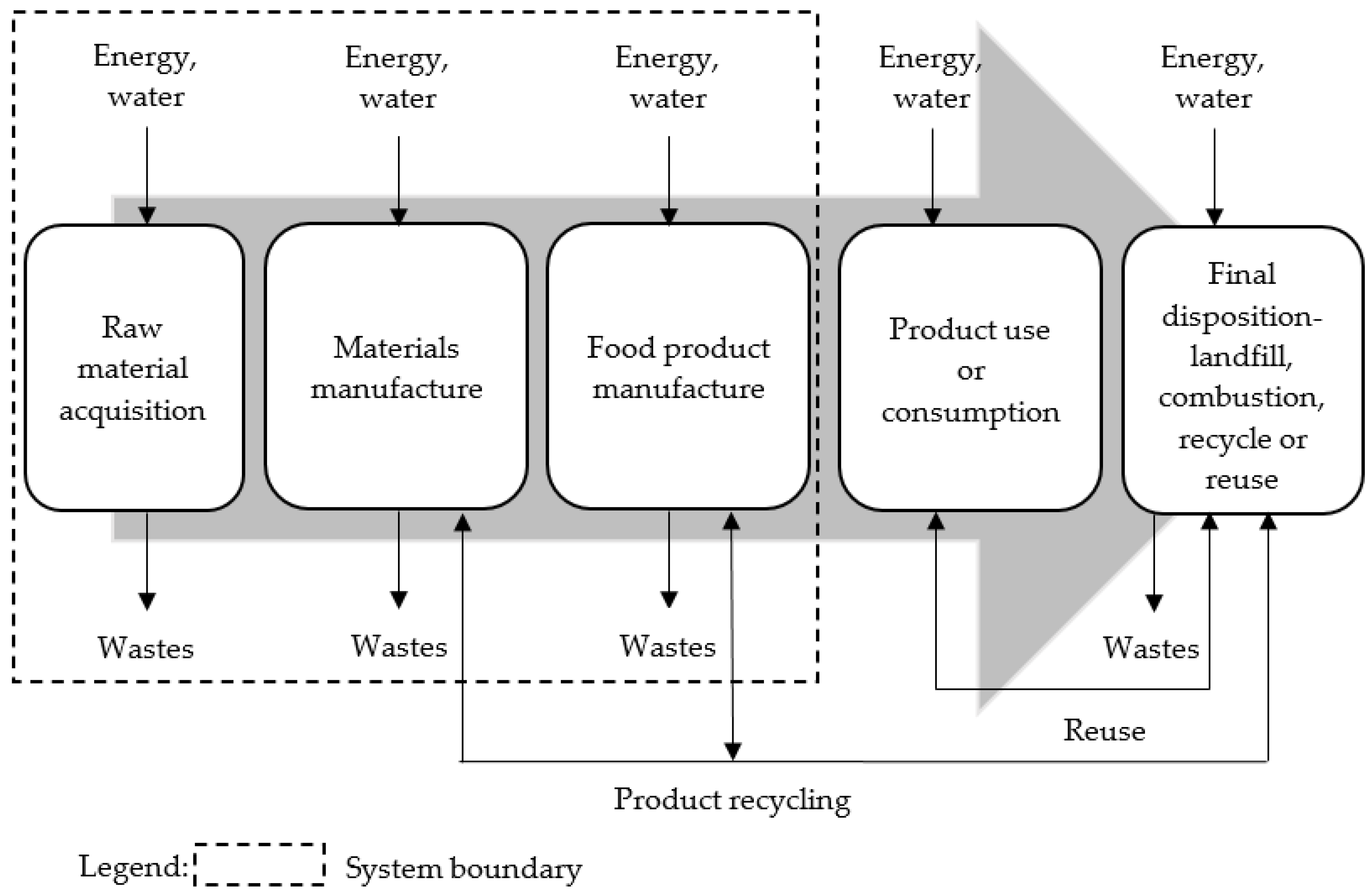
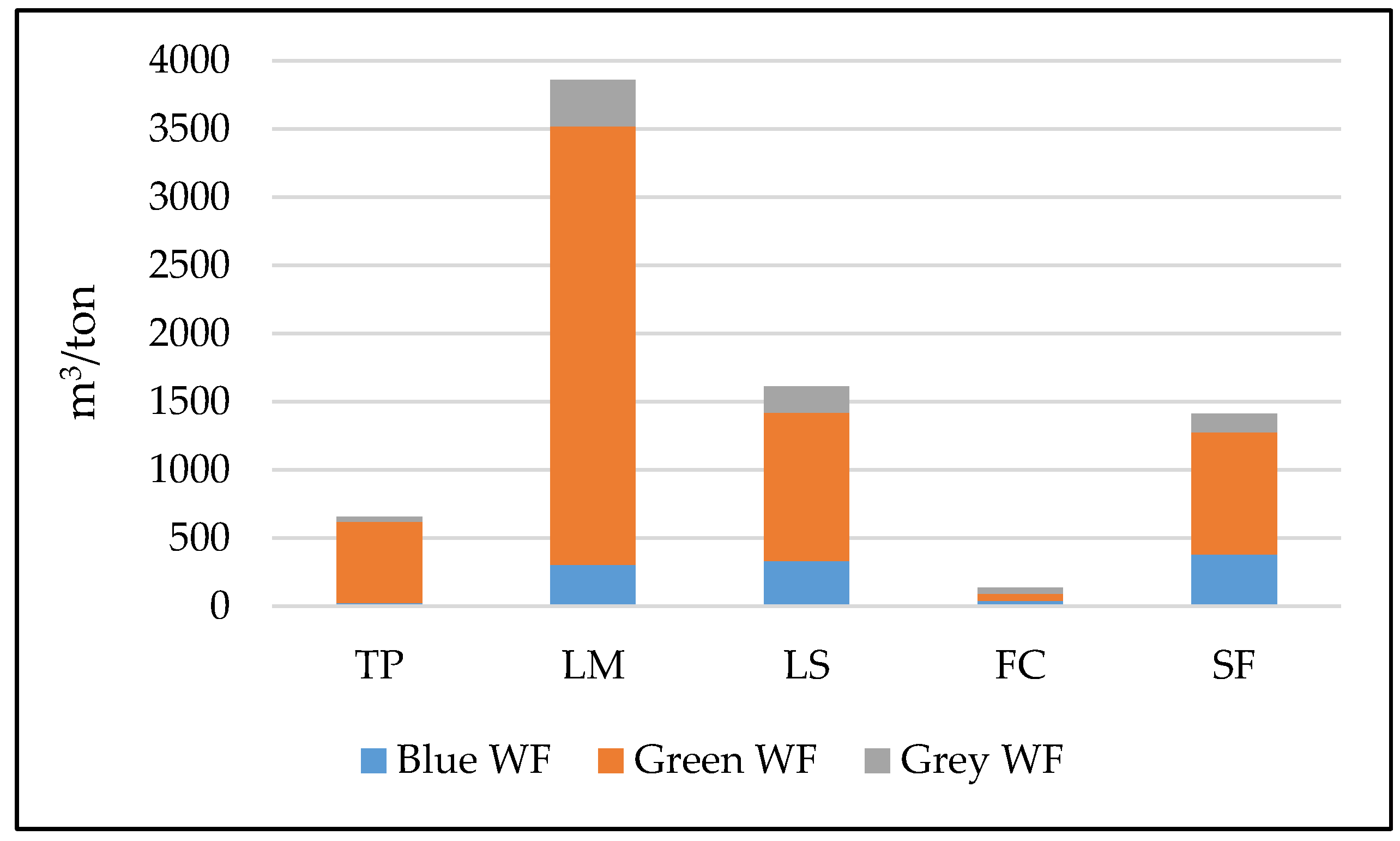

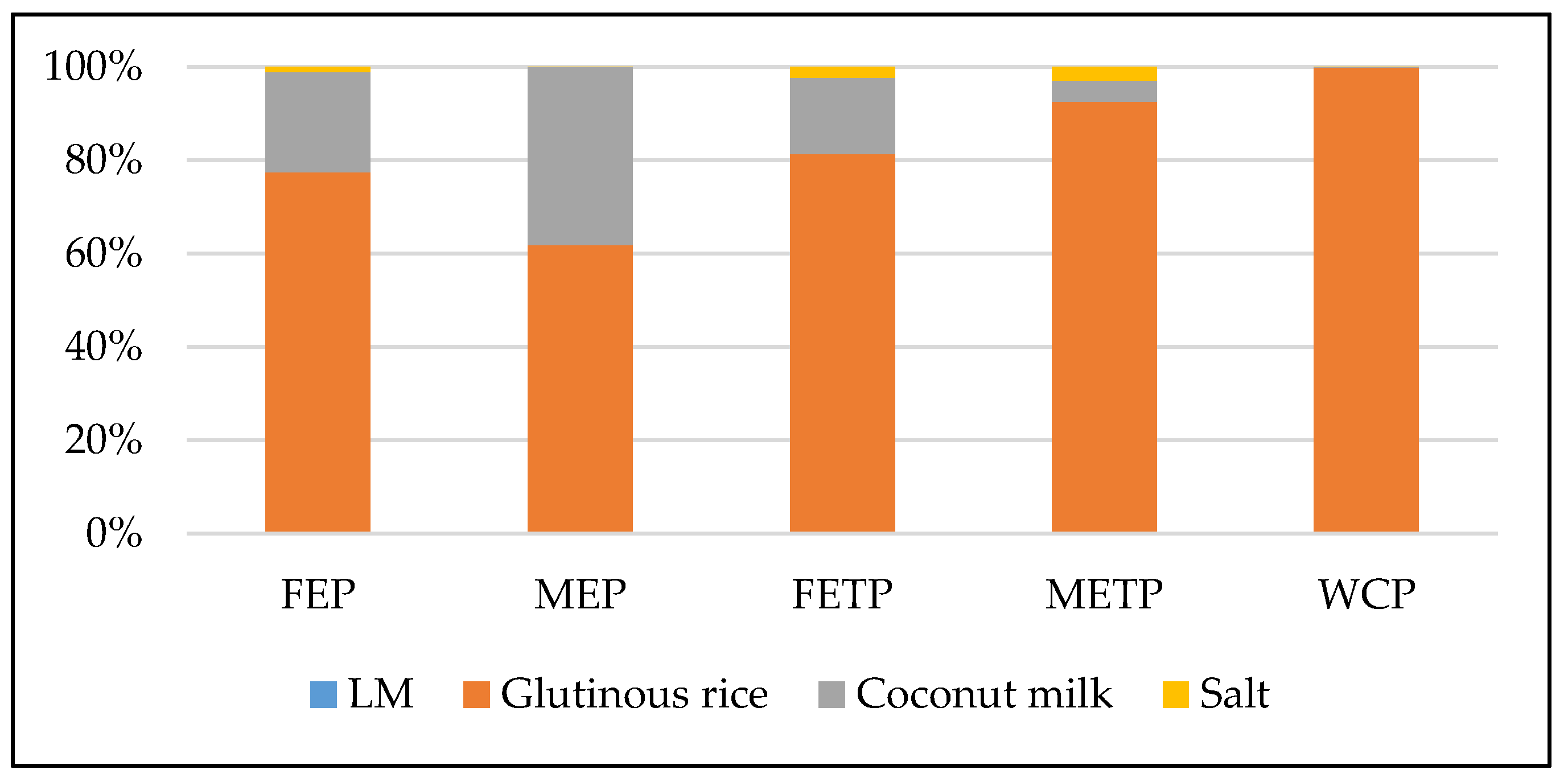
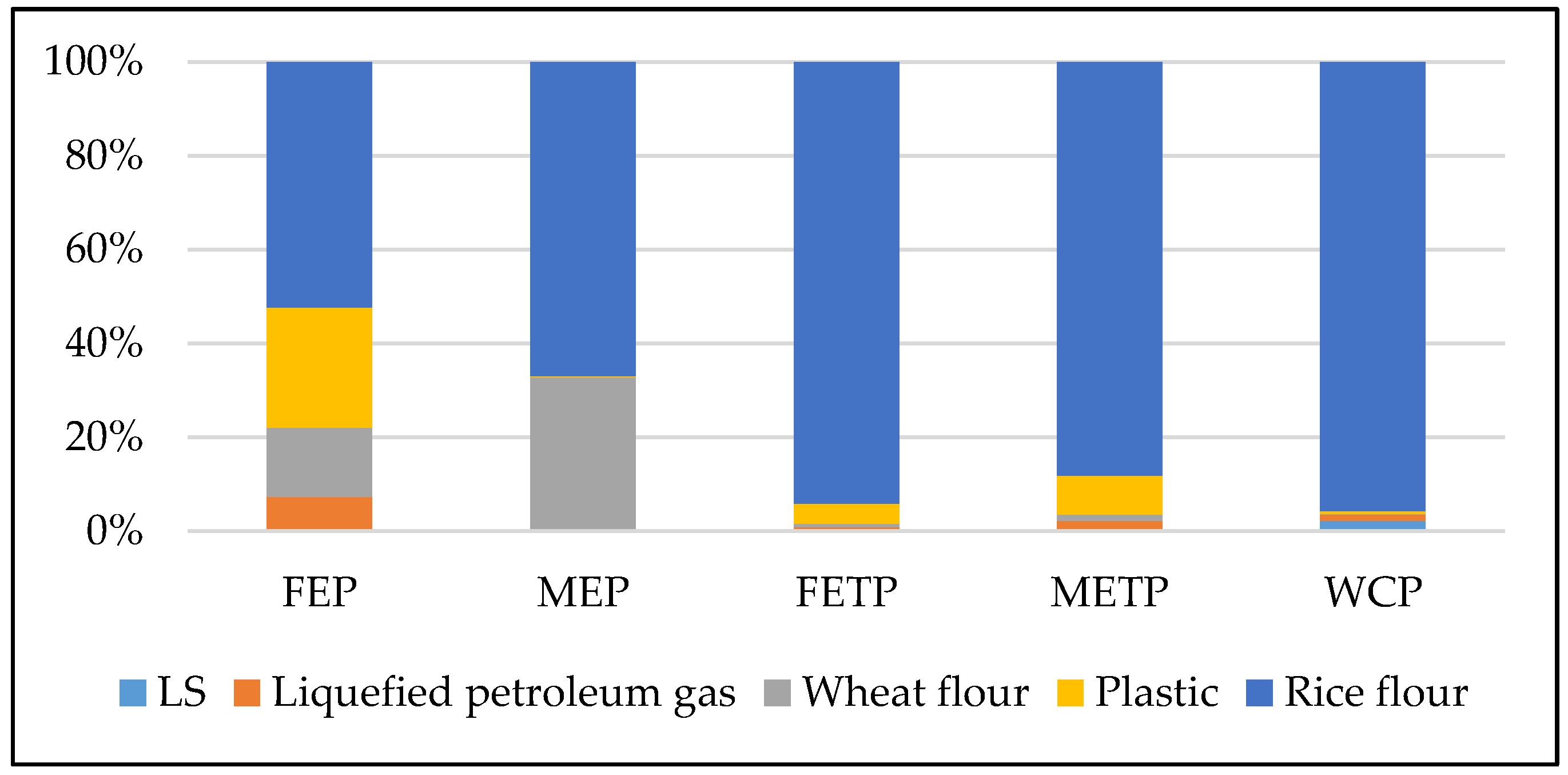
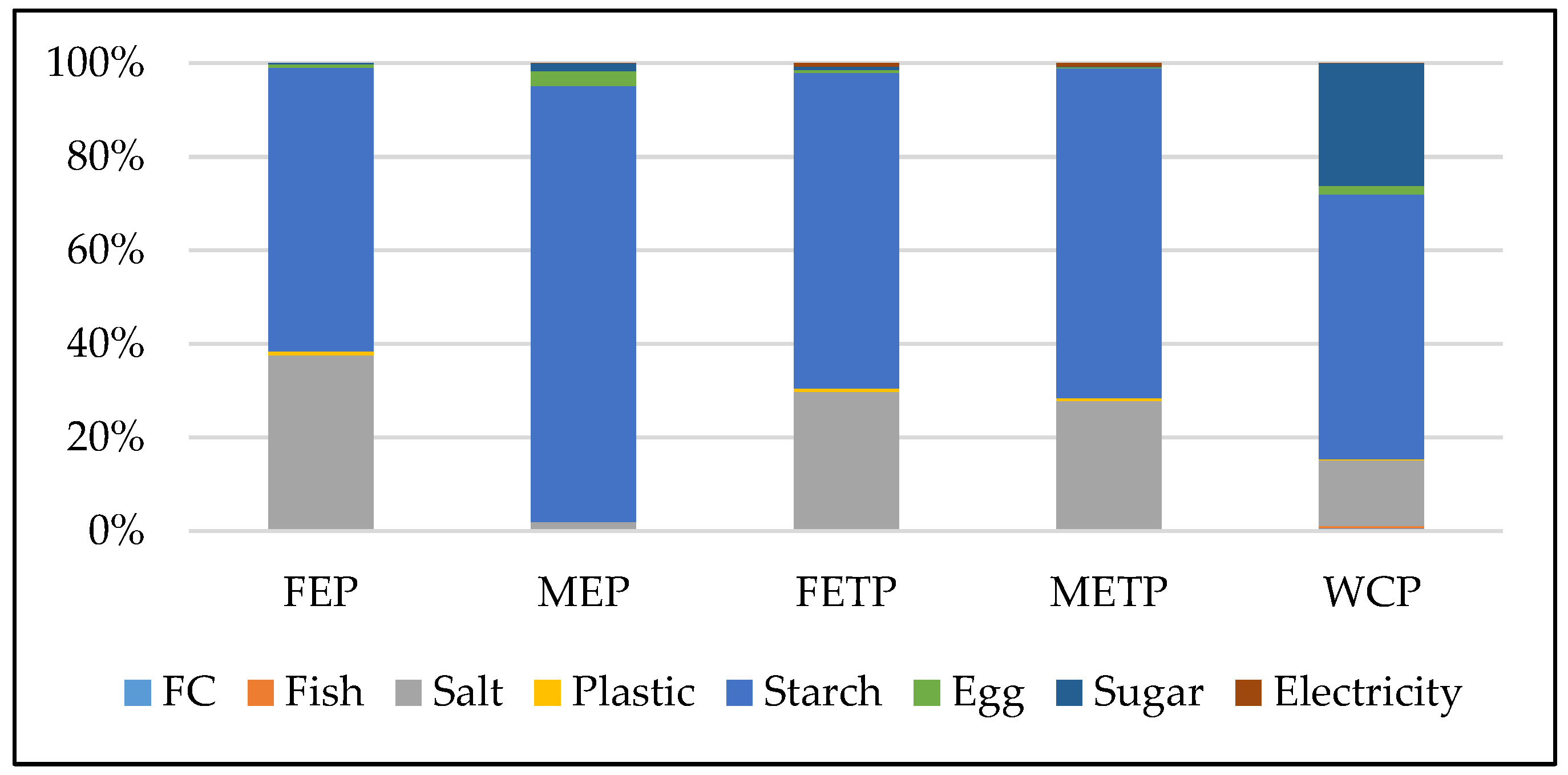
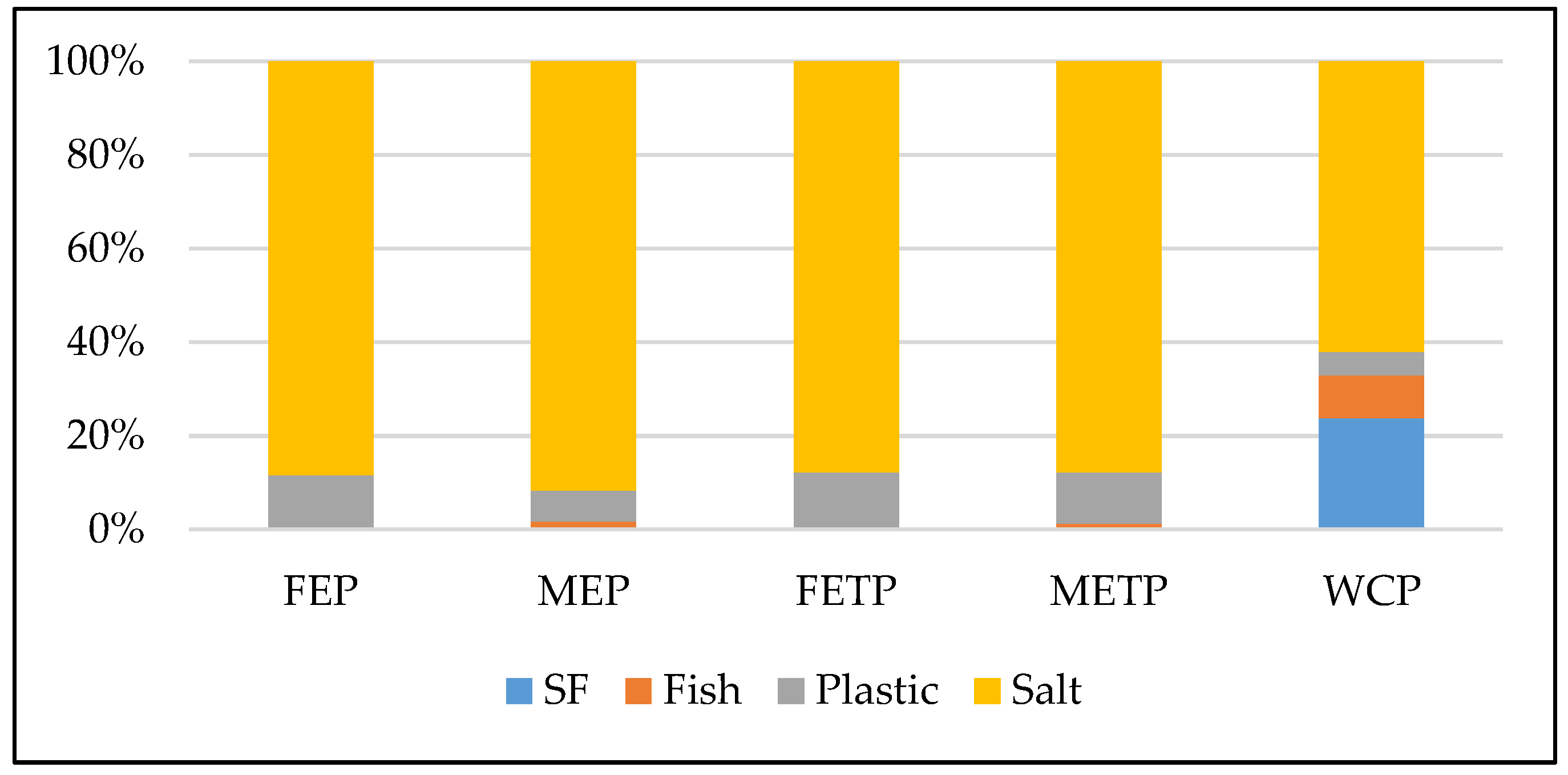
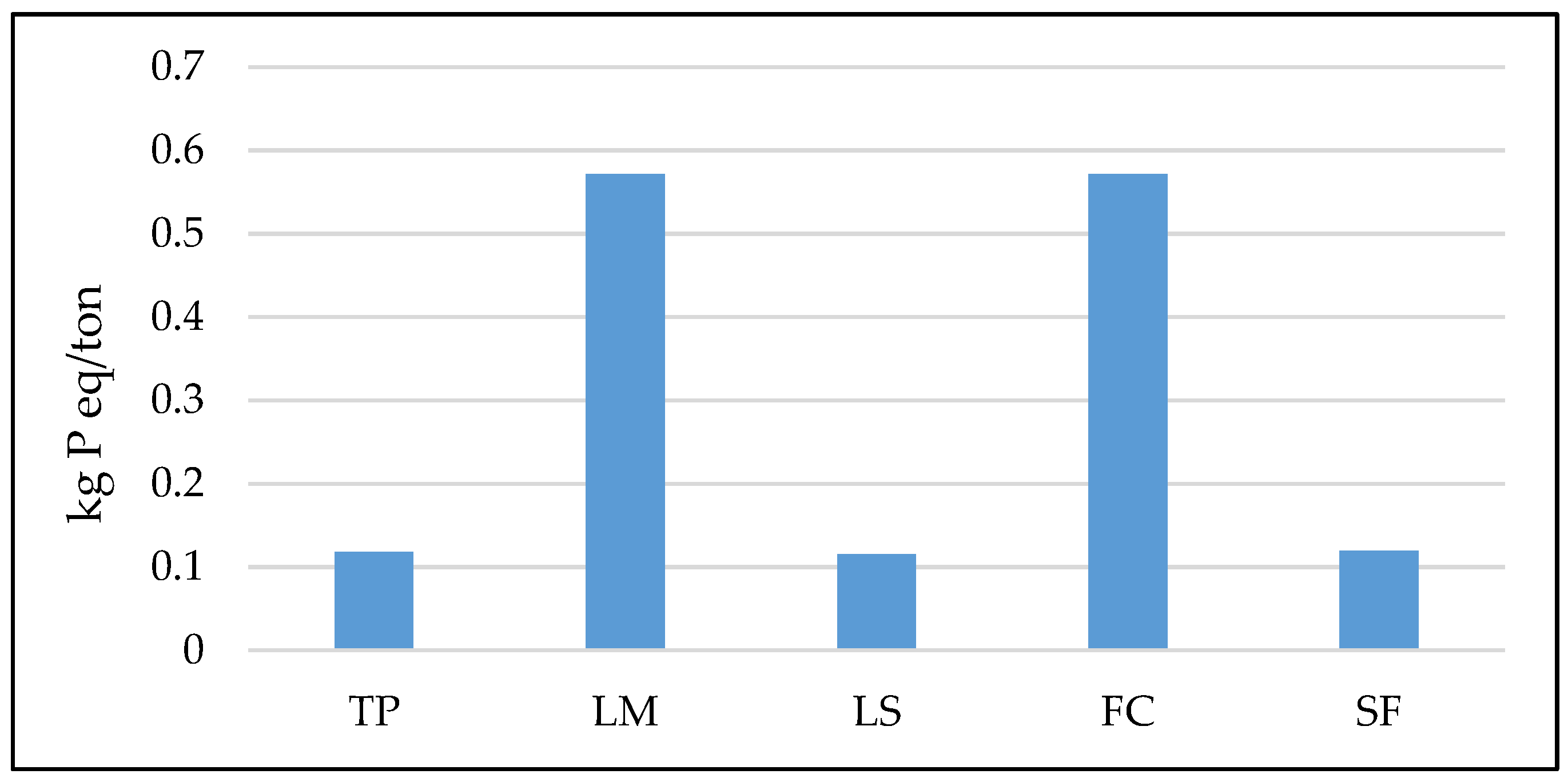
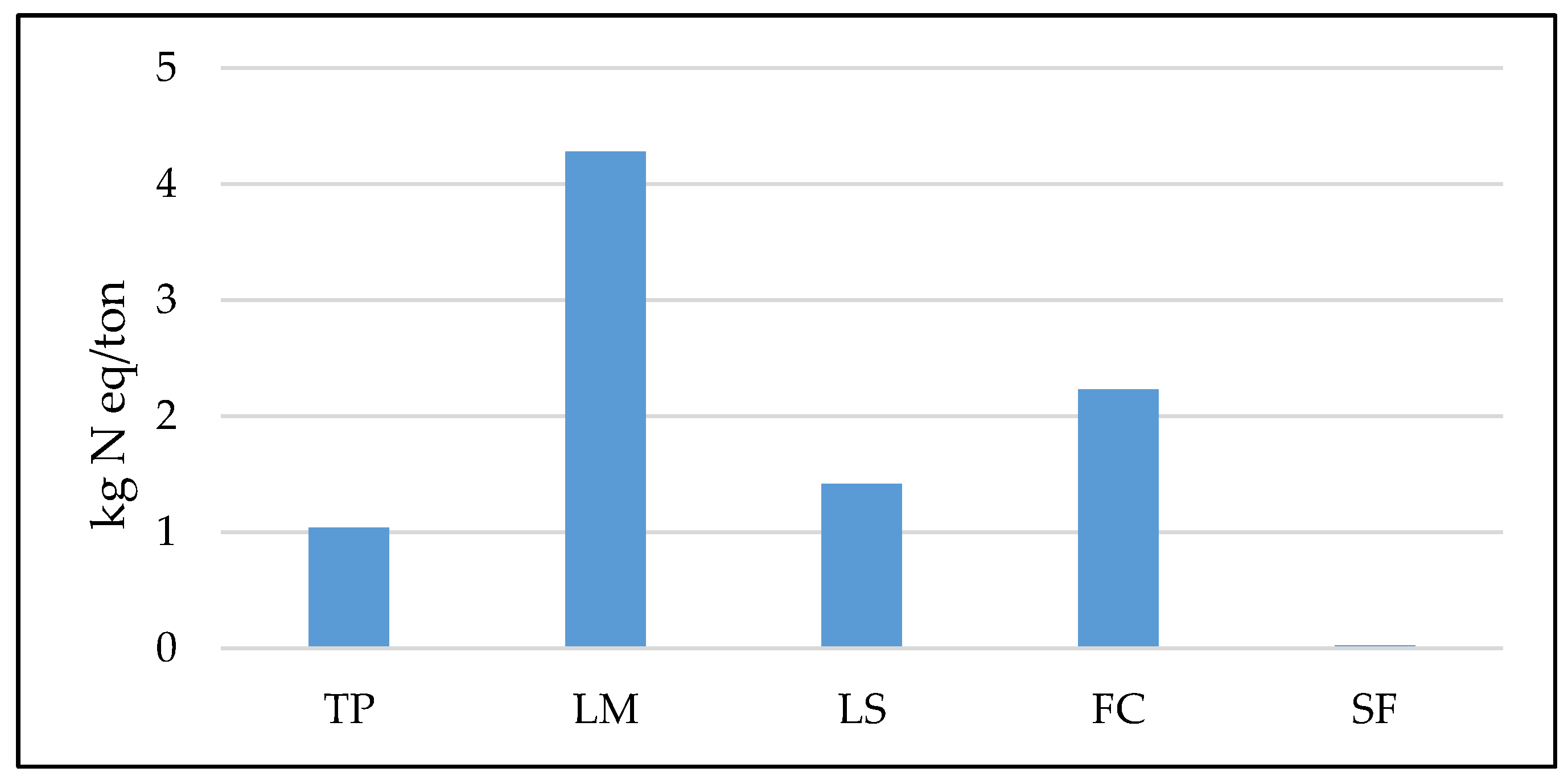
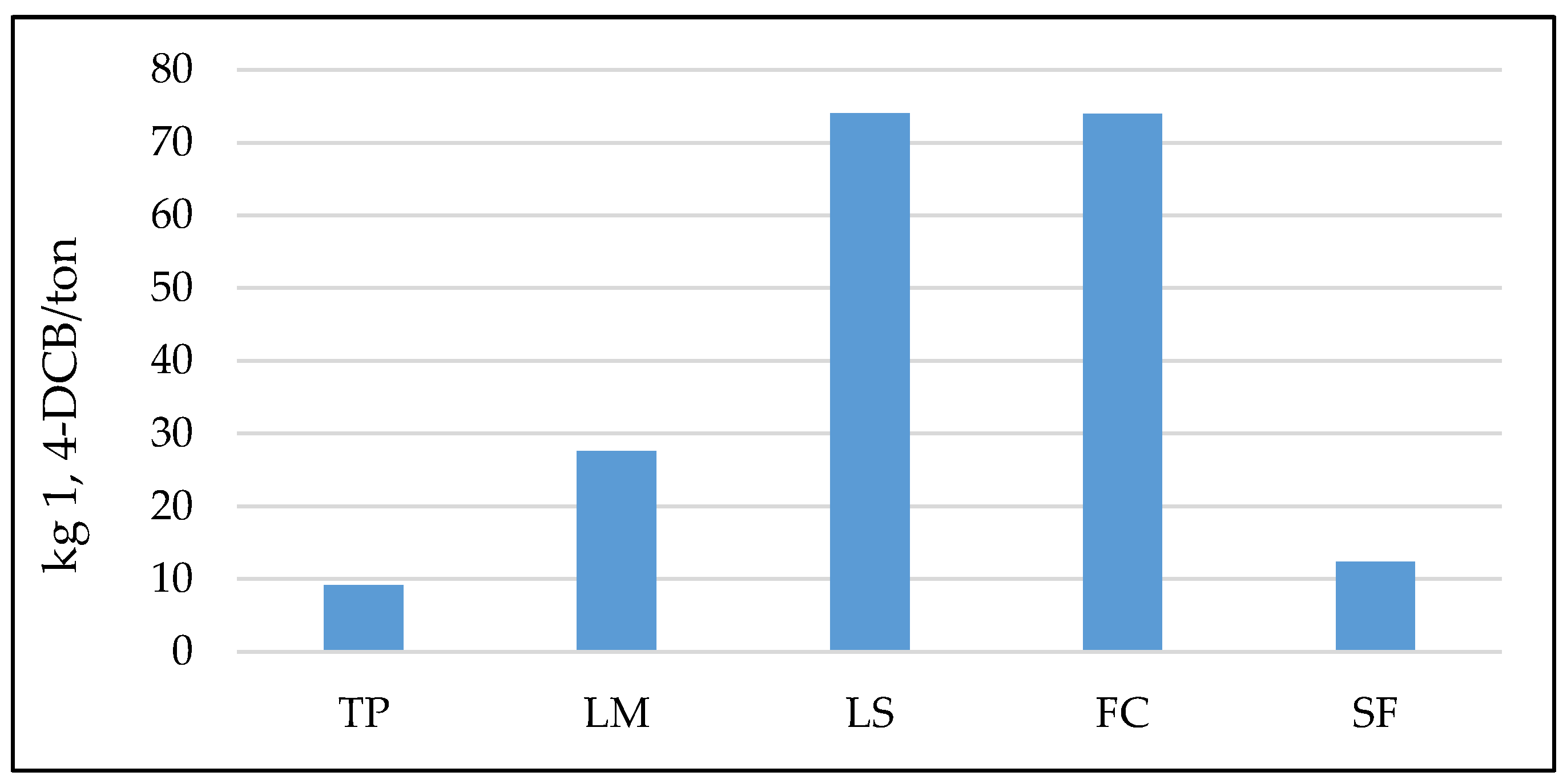
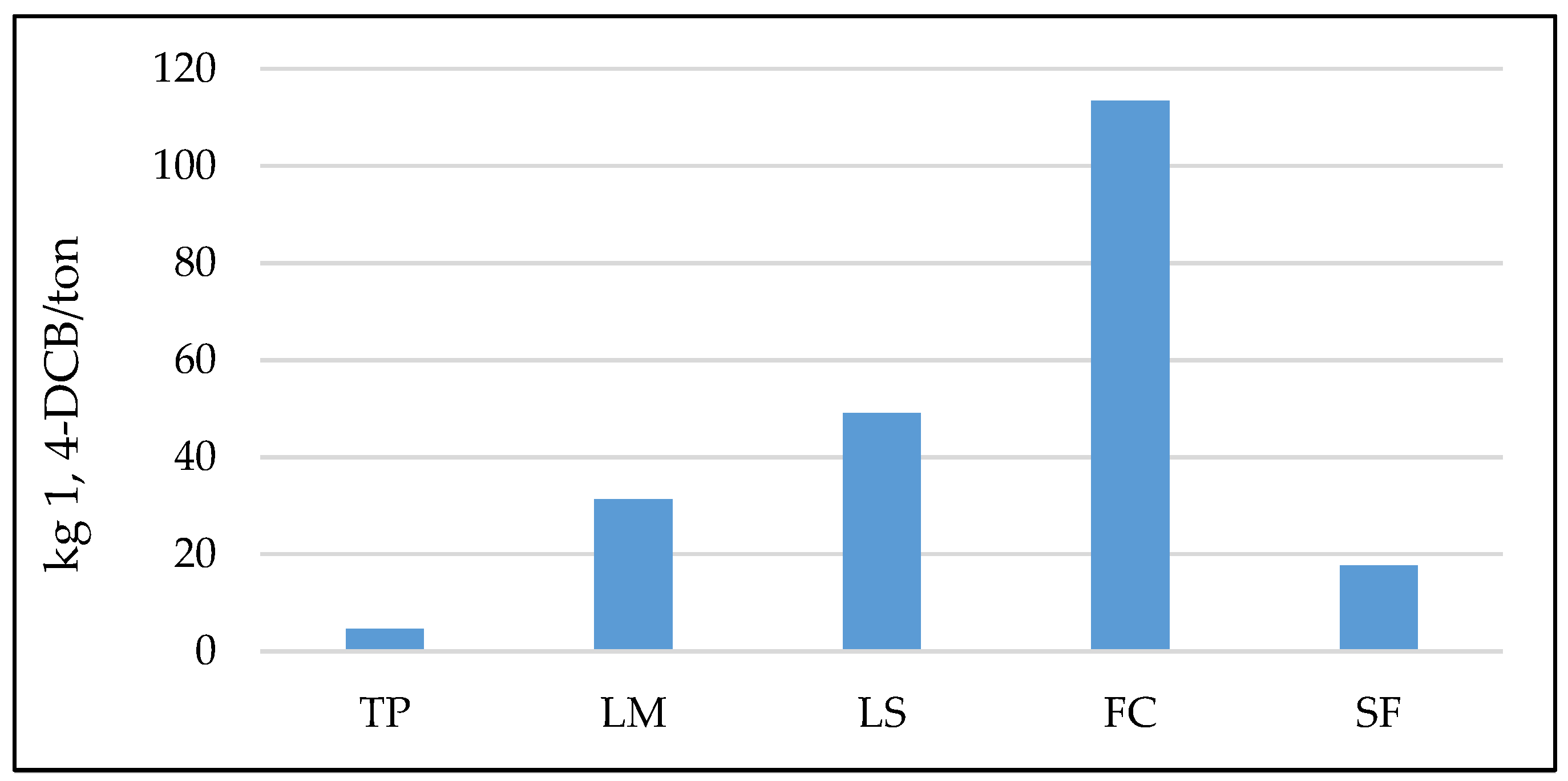

| Food Product | Materials | Reference |
|---|---|---|
| Tempe (TP) | Soybean | Mekonnen, Hoekstra, 2010b [21] |
| Yeast | Franzén, 2014 [24] | |
| Liquefied petroleum gas (LPG) | Kandananond, Author, 2018 [22] | |
| Electricity | Kandananond, Author, 2018 [22] | |
| Plastic | Water Footprint Network, 2007 [23] | |
| Lemang (LM) | Glutinous rice | Mekonnen, Hoekstra, 2010b [21] |
| Coconut milk | Mekonnen, Hoekstra, 2010b [21] | |
| Salt | Mekonnen, Hoekstra, 2010b [21] | |
| Noodle laksam (LS) | Rice flour | Mekonnen, Hoekstra, 2010b [21] |
| Wheat flour | Mekonnen, Hoekstra, 2010b [21] | |
| LPG | Kandananond, Author, 2018 [22] | |
| Plastic | Water Footprint Network, 2007 [23] | |
| Fish cracker (FC) | Fish | Ecoinvent 3.4 Database [25] |
| Starch | Ecoinvent 3.4 Database [25] | |
| Egg | Mekonnen, Hoekstra, 2010a [20] | |
| Salt | Mekonnen, Hoekstra, 2010b [21] | |
| Sugar | Mekonnen, Hoekstra, 2010b [21] | |
| Plastic | Water Footprint Network, 2007 [23] | |
| Electricity | Kandananond, Author, 2018 [22] | |
| Salted fish (SF) | Fish | Ecoinvent 3.4 Database [25] |
| Salt | Mekonnen, Hoekstra, 2010b [21] | |
| Plastic | Water Footprint Network, 2007 [23] |
| Authors, Year | Food Types | Functional Unit | System Boundary | Method | Impact Categories |
|---|---|---|---|---|---|
| Lansche et al., (2020) [30] | Crisps | 1 kg of crisps | Cradle-to-gate | SALCA | CED, DEF, WSI, GWP, OFP, AP, HTP, ETP |
| Borsato et al., (2019) [3] | Wine | 750 mL of wine | Cradle-to-gate | AWARE, IMPACT 2002+, ILCD 2001, ReCiPe 2016 | WSI, AP, ETP, EP |
| Bhattacharyya et al., (2019) [31] | Vodka | 750 mL of vodka | Cradle-to-grave | ReCiPe 2016 | ETP, EP, CC, LU |
| Perez-Martinez et al., (2018) [32] | Pork lean can, meatballs with peas can | 220 g of pork lean can, 430 g of meatballs with peas can | Cradle-to-grave | ReCiPe 2016 | ETP, CC, DEP, AP, EP, LU |
| Caldeira et al., (2018) [33] | Palm rapeseed, soya, waste cooking oil | 1 kg of each food product | Cradle-to-gate | IMPACT 2002+, ReCiPe 2008, USETox | ETP, EP, AP |
| Jimmy et al., (2017) [34] | Rice | 1 kg of rice | Gate-to-gate | ReCiPe 2016 | ETP, CC, DEP, AP, EP, LU |
| Cha et al., (2017) [35] | White radish | 1 ton of white radish | Cradle-to-gate | EUTREND, ReCiPe 2016 | EP, WD |
| Huerta et al., (2016) [36] | Boneless beef, fatless beef | 1 kg of boneless beef, 1 kg of fatless beef | Cradle-to-grave | ReCiPe 2008 | ETP, CC, DEP, AP, EP, LU |
| Nilsson et al., (2011) [37] | Crisps | 200 g of crisps | Cradle-to-gate | IPCC, CML2001 | GHG, EP, EU |
| Bevilacqua et al., (2007) [38] | Pasta | 0.5 kg of pasta | Cradle-to-grave | EDIP, EPS 2000, CML 2, Eco-indicator 99 | ETP, AP, EP, LU |
| 1 Ton of Products (1) | Parameter Input/Output (2) | Ingredient (3) | Quantity (4) |
|---|---|---|---|
| Tempe (TP) | Resource | Water | 1491.228 L |
| Materials/fuels | Soybean | 0.292 ton | |
| Liquefied petroleum gas (LPG) | 4.094 kg | ||
| Plastic | 17.5000 kg | ||
| Electricity/heat | Electricity | 10.526 kWh | |
| Emissions to water | Total suspended solids (TSS) | 3.395 mg | |
| Chemical oxygen demand (COD) | 700,526.376 mg | ||
| Biological oxygen demand (BOD) | 33,115.792 mg | ||
| Ammonia | 390,065.823 mg | ||
| Lemang (LM) | Resource | Water | 81.019 L |
| Materials/fuels | Glutinous rice | 833.333 kg | |
| Coconut milk | 833.333 kg | ||
| Salt | 33.333 kg | ||
| Emissions to water | TSS | 3.188 mg | |
| COD | 2,470,671.294 mg | ||
| BOD | 62,165.277 mg | ||
| Ammonia | 12,353.356 mg | ||
| Noodle laksam (LS) | Resource | Water | 1402.778 L |
| Materials/fuels | Wheat flour | 222.222 kg | |
| Rice flour | 444.444 kg | ||
| LPG | 124.444 kg | ||
| Plastic | 100.000 kg | ||
| Emissions to water | TSS | 15.980 mg | |
| COD | 1,764,458.333 mg | ||
| BOD | 67,360.139 mg | ||
| Ammonia | 41,614.583 mg | ||
| Fish cracker (FC) | Resource | Water | 200.000 L |
| Materials/fuels | Fish | 1000.000 kg | |
| Salt | 1127.300 kg | ||
| Sugar | 8.500 kg | ||
| Starch | 1100.000 kg | ||
| Egg | 100 p | ||
| Plastic | 17.500 kg | ||
| Electricity/heat | Electricity | 340.000 kWh | |
| Emissions to water | TSS | 13.922 mg | |
| COD | 2,241,066.667 mg | ||
| BOD | 36,926.667 mg | ||
| Ammonia | 444,096.222 mg | ||
| Salted fish (SF) | Resource | Water | 829.034 L |
| Materials/fuels | Fish | 2000.000 kg | |
| Salt | 555.556 kg | ||
| Plastic | 46.667 kg | ||
| Emissions to water | TSS | 74.545 mg | |
| COD | 3,313,848.214 mg | ||
| BOD | 62,753.036 mg | ||
| Ammonia | 656,467.232 mg |
| Food Products | WSblue | WPL |
|---|---|---|
| Tempe (TP) | 0.000045 | 0.000037 |
| Lemang (LM) | 0.000533 | 0.000359 |
| Noodle laksam (LS) | 0.002715 | 0.000923 |
| Fish cracker (FC) | 0.000070 | 0.000042 |
| Salted fish (SF) | 0.001394 | 0.000294 |
© 2020 by the authors. Licensee MDPI, Basel, Switzerland. This article is an open access article distributed under the terms and conditions of the Creative Commons Attribution (CC BY) license (http://creativecommons.org/licenses/by/4.0/).
Share and Cite
Bong, P.X.H.; Malek, M.A.; Mardi, N.H.; Hanafiah, M.M. Cradle-to-Gate Water-Related Impacts on Production of Traditional Food Products in Malaysia. Sustainability 2020, 12, 5274. https://doi.org/10.3390/su12135274
Bong PXH, Malek MA, Mardi NH, Hanafiah MM. Cradle-to-Gate Water-Related Impacts on Production of Traditional Food Products in Malaysia. Sustainability. 2020; 12(13):5274. https://doi.org/10.3390/su12135274
Chicago/Turabian StyleBong, P.X.H., M.A. Malek, N.H. Mardi, and Marlia M. Hanafiah. 2020. "Cradle-to-Gate Water-Related Impacts on Production of Traditional Food Products in Malaysia" Sustainability 12, no. 13: 5274. https://doi.org/10.3390/su12135274
APA StyleBong, P. X. H., Malek, M. A., Mardi, N. H., & Hanafiah, M. M. (2020). Cradle-to-Gate Water-Related Impacts on Production of Traditional Food Products in Malaysia. Sustainability, 12(13), 5274. https://doi.org/10.3390/su12135274





